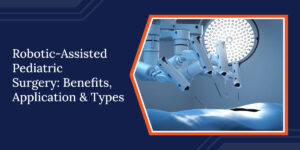
Recognising urology problems in a baby boy early allows for more effective treatment and better outcomes. Hence, it is important to stay aware of any signs and seek timely medical consultation to prevent potential complications.
In this blog, we will discuss some of the common paediatric urological problems in boys, including undescended testicles, hypospadias, phimosis, and more, along with their symptoms and treatment options.
A] Understanding Pediatric Urology problems in Baby Boys
Paediatric urology is a branch of medicine that focuses on diagnosing and treating urinary and genital systems in children. In boys, the symptoms may include difficulty in urination, abdominal or back pain, fever, swelling, or redness around the testicles. Paediatric urology problems in boys often occur during the early stages of development, as the urinary system in children is still maturing and is more at risk of certain issues that may require medical attention.
Protect Your Boy’s Health – Discover Common Issues!
B] Common Pediatric Urology Problems in male child
1. Undescended Testicles (Cryptorchidism)
Undescended testicles, or cryptorchidism, is a condition in which testicles fail to move down into their proper place in the scrotum before birth. Generally, it is just one testicle that doesn’t move down. This condition is less common in full-term infants and occurs more frequently in premature babies. Normally, an undescended testicle moves down on its own within a few months after birth; however, surgical intervention can be considered if it does not occur.
A healthcare provider can diagnose undescended testicles during a physical examination. If they can’t feel the testicles (impalpable), the child may have cryptorchidism. If left untreated, the possible complications include fertility issues later in life, inguinal hernia, and the risk of testicular cancer. The treatment options include hormone therapy and surgery (orchidopexy), in which the surgeon moves the testicle into the scrotum by incision.
2. Hypospadias
Hypospadias is a condition present at birth where the urethral opening is on the underside of the penis. In most cases, the opening is within the head of the penis; however, in some severe cases, it is at the middle or base of the penis. The condition may be caused by genetics or hormonal factors and can be corrected with hypospadias surgery.
3. Phimosis and Paraphimosis
Phimosis is defined as a condition or inability to pull back the foreskin covering the head of the penis. It is common in infants and young children, as their tight foreskin usually loosens as they get older. A healthcare provider can diagnose and recommend additional tests if an infection is suspected during a physical exam. Treatment options may range from steroid creams to gentle retraction techniques or even circumcision, depending on the severity.
Paraphimosis occurs when the retracted foreskin cannot be drawn back to its normal position over the head of the penis. It can cause pain and swelling and affect the normal blood flow in the penis. It is a rare condition, normally found in uncircumcised children between 4 months and 12 years of age. The treatment options can include manual reduction by cool compressions, painkillers, a minor procedure, or circumcision.
4. Hydrocele
A hydrocele is a common condition in newborns, and it is identified by swelling in the scrotum, the pouch that holds the testicles. The swelling is due to fluid buildup in the thin sac surrounding a testicle. In the case of newborns, it usually resolves on its own. However, a healthcare professional can be consulted if the issue persists beyond one year and the swelling worsens. This condition can also occur in children and adults.
5. Inguinal Hernia
In an inguinal hernia, a part of the intestine or abdominal tissue protrudes through a weak spot in the inguinal canal located in the groin area. It is a more frequent condition in baby boys that can result in a soft bulge or swelling in the groin area. Symptoms may include inconsolable crying, discomfort in the groin, and a swollen scrotum. Surgery is the only effective treatment to close the opening in infants. The procedure is either performed by a paediatric surgeon or a paediatric urologist.
6. Vesicoureteral Reflux (VUR)
Vesicoureteral reflux (VUR) is a common condition in infants and young children in which urine flows backwards from the bladder to one or both ureters. In some cases, the urine may reach the kidneys. A child with VUR may experience urinary tract infections (UTIs), bladder-related problems, including bedwetting, and bowel problems. A professional can diagnose VUR with several imaging and lab tests, including abdominal ultrasound and voiding cystourethrogram (VCUG).
7. Urinary Tract Infections (UTIs) in Baby Boys
Urinary tract infections (UTIs) usually develop when bacteria enter the bladder, remain there, and begin to multiply. Normal urine is free of germs, containing water, salts, and waste products. The most common cause of UTIs is Escherichia coli (E. coli), a bacterium found in the digestive tract. UTIs are less common in boys of any age, as they have a longer urethra, which makes it harder for bacteria to reach the bladder. However, it can still occur, especially in uncircumcised boys, with poor hygiene or in cases of vesicoureteral reflux (VUR). Antibiotics, either oral or intravenous, good hygiene practices, and proper testing can be part of treatment and preventive care.
8. Posterior Urethral Valves (PUV) – A Serious Congenital Condition
Posterior urethral valves (PUV), a congenital condition, are the obstructive membranes that develop in the urethra near the bladder. Although PUVs are rare, they are the most common type of bladder outlet obstruction in newborns, particularly male infants. These valves can impede or stop the flow of urine out of the bladder, which can result in bladder problems, kidney damage, and other long-term complications. The symptoms may not surface in mild cases until age 10 or older and can vary from child to child. Some common symptoms include painful urination and a weak urine stream.
In most cases, a minimally invasive surgical procedure called endoscopic incision is the preferred treatment option. Also known as urethral valve ablation, this technique involves trimming down excessive tissue of the valves.
C] When to See a Pediatric Urologist?
Parents, especially newborns, need to stay observant of any signs indicating the need for medical intervention. Some signs, such as bedwetting beyond the typical age, difficulty while urinating, or unexplained abdominal discomfort or pain, may seem temporary and can often be overlooked. However, they can be indicators of an underlying condition. This is where routine check-ups play a crucial role.
Parents need to consult a paediatrician as soon as the signs are visible. A paediatrician often refers to a paediatric urologist if they suspect something beyond general care. Paediatric urologists are specialists trained to cater to the needs of children, both medically and emotionally, with a child-friendly approach.
If your child is diagnosed with a complex urological problem that requires expert attention, you can consider seeking guidance from a paediatric surgeon in Dubai.
Timely consultation with the right paediatric professionals not only helps parents understand a range of potential issues but also ensures early diagnosis and treatment, which can prevent serious complications in the future.
Protect Your Boy’s Health – Discover Common Issues!
Conclusion
Infancy and childhood are very important phases during which children experience growth in every aspect. However, during this time, they may also encounter a range of conditions that, if left untreated, can develop serious complications in the future. This is particularly true for baby boy urinary problems; hence, parents need to stay informed, pay attention to the signs, and consult a medical expert if they find anything concerning.
While many conditions are rare and often get resolved on their own, one should not delay seeking medical advice to guarantee the same and avoid unnecessary risks. Consider booking an appointment with Dr Bhushanrao Jadhav, a paediatric urologist in Dubai, who focuses on providing effective treatments for a wide range of complex urological problems in young patients. Treatment from such trusted professionals not only helps to overcome various conditions but also ensures long-term well-being.

Dr. Bhushanrao Jadhav
Dr. Bhushanrao Jadhav is a highly skilled Pediatric Surgeon and Urologist specialising in minimally invasive and robotic surgeries for children. With advanced training from leading institutions in the UK, India and USA, he brings expertise in treating complex genitourinary conditions and neonatal surgical ailments. Driven by compassion and innovation, Dr. Jadhav has pioneered pediatric robotic surgery programs in Pune, India, ensuring world-class care tailored to children’s unique needs.




















